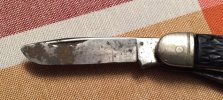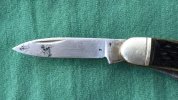- Joined
- Feb 11, 2016
- Messages
- 2,541
A couple of threads over on the Traditionals subforum have inspired me and I want to try my hand at modifying a few pocket knife blades. My first project will be converting the spey blade of an old Camillus stockman into a pen blade. I'm really excited to dig in.
I've seen several recommendations to use filesas opposed to, say, a belt sander or Dremel toolfor this sort of work, especially while learning. That makes sense to me. I've never done any metal work, though, and am a bit overwhelmed at the options available. I'd appreciate some guidance on putting together a starter set of files that I can use for projects like this.
Here are some more details of what I'm looking to do in case they help narrow down the field:
- Traditional folders with blades of about 3" or less, primarily carbon steel like 1095
- Reshaping and restoration: spey to pen, clip to wharncliffe/sheepsfoot, adding or extending a sharpening notch
- As a bonus, perhaps eventually shaping replacement Micarta scales (are files appropriate for that?), but that's not a necessity now if it would require files not needed for the blades
What type(s) and shape(s) of files do I need at a minimum to get started and what is the purpose of each? Do I need different grits (or whatever the equivalent is for files)? Any brand recommendations? I'd like to keep it simple and inexpensive in case I am surprised and find that blade modification isn't for me. On the other hand, I don't want to waste money by buying something that is of poor quality and I'll just end up replacing in the near future.
That's a lot of questions, I know, and I may not even be asking the right ones. Any guidance and advice is very much appreciated.
Thanks,
Greg
I've seen several recommendations to use filesas opposed to, say, a belt sander or Dremel toolfor this sort of work, especially while learning. That makes sense to me. I've never done any metal work, though, and am a bit overwhelmed at the options available. I'd appreciate some guidance on putting together a starter set of files that I can use for projects like this.
Here are some more details of what I'm looking to do in case they help narrow down the field:
- Traditional folders with blades of about 3" or less, primarily carbon steel like 1095
- Reshaping and restoration: spey to pen, clip to wharncliffe/sheepsfoot, adding or extending a sharpening notch
- As a bonus, perhaps eventually shaping replacement Micarta scales (are files appropriate for that?), but that's not a necessity now if it would require files not needed for the blades
What type(s) and shape(s) of files do I need at a minimum to get started and what is the purpose of each? Do I need different grits (or whatever the equivalent is for files)? Any brand recommendations? I'd like to keep it simple and inexpensive in case I am surprised and find that blade modification isn't for me. On the other hand, I don't want to waste money by buying something that is of poor quality and I'll just end up replacing in the near future.
That's a lot of questions, I know, and I may not even be asking the right ones. Any guidance and advice is very much appreciated.
Thanks,
Greg





